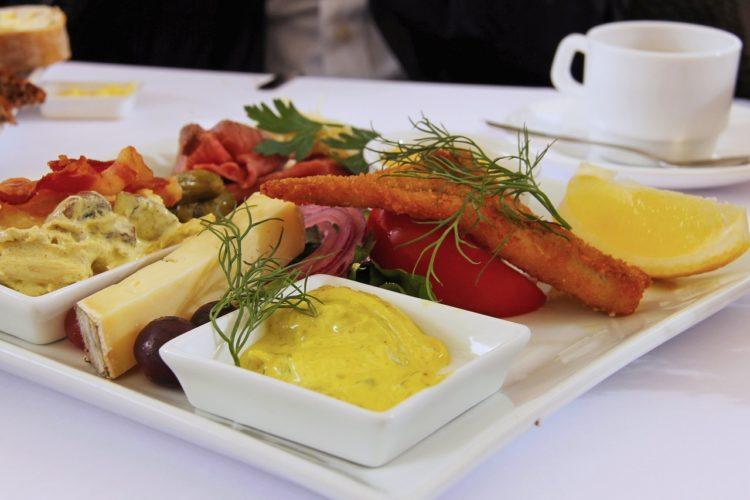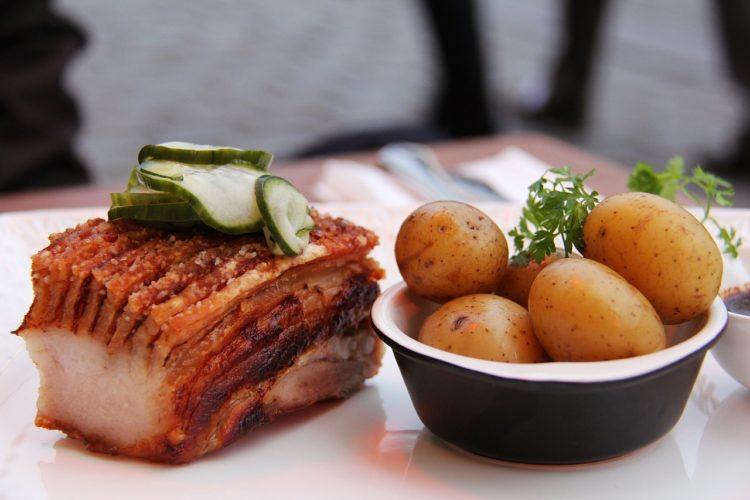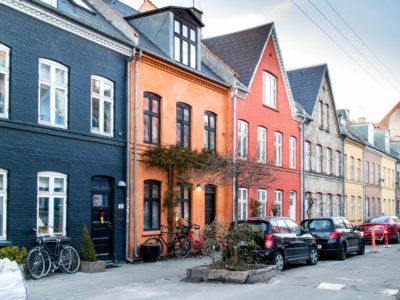Headed to Scandinavia and looking for the best things to eat in Copenhagen? Keep reading for not only what to eat in Copenhagen, but where to find them, local specialties, the cities’ top rated restaurants, and the best cheap eats in Copenhagen.

Danish food, well, actually all food from the Scandinavian region gets a bad rep, except for those drool-worthy Swedish meatballs of course. That dish will always be exempt from looks of mild disgust and mockery (thanks Ikea).
People have the misconception that in Denmark, locals primarily eat raw fish, and not in a good sushi or ceviche-prepared kind of way. But those same mis-informed people have been wrong, oh so very wrong.
While the Danish do eat their fair share of seafood, there’s plenty else to find food-wise in the city of Copenhagen.

And yes, this includes one of the world’s most celebrated restaurants (you heard me say world, right?). Noma, recipient of not one but two Michelin stars, was the brainchild of Danish chef Rene Redzepi, and is located right here in Copenhagen.
If you’re unable to secure a reservation at the eatery (I mean, it was voted the best restaurant in the world four times), or just don’t want to shell out the Kroner for it, pick and choose from these Copenhagen restaurants and cheap eats.
Below you’ll find 10 Danish foods you don’t want to miss on a trip to Copenhagen. And trust me, they’re just as good as the food you’ll find at Noma. Despite locals looking Scandi-chic, you may just wanna change into your stretchy pants for an afternoon (or 2 or 3) of eating.
Best things to eat in Copenhagen
1. Danish Hot Dog
Pølser is the Danish word for sausage, and pølsevogen- hot dog wagons- are one of the most common sights you’ll see on the streets of Copenhagen (they’re everywhere).
If you think hot dogs are a new thing to Denmark, a result of globalization rearing its fun-lovin’ head, think again. Hot dog sausages have been ubiquitous in Denmark for more than a century and today are one of its most popular street foods and cheap eats in Copenhagen.
The hot dog is always grilled, resting over the edges of its bun, and usually adorned with raw onions, fried onions, sliced pickles, mustard, ketchup, and Danish remoulade. It’s delicious and for Danish prices, inexpensive.
The best spot for a Danish dog is at DØP which serves its dogs using 100% organic ingredients. Thankfully there’s two locations in Copenhagen- at the Round Tower (Købmagergade 52A) and the Church of the Holy Ghost (Niels Hemmingsens Gade 5).
2. Danish Meatballs
Oh, so you thought only the Swedish could claim rights to the meatball? Well, think again. Danish meatballs may be less well-known than their neighbor’s to the east but that doesn’t mean they’re any less delicious. Frikadeller are typically served on rye bread and what sets them apart from Swedish meatballs is that frikadeller contains ground pork, making them fluffier.
3. Smørrebrød
While these famous open-face sandwiches can be found throughout Scandinavia, smørrebrød originated in Denmark and are one of the country’s most iconic foods. They typically consist of buttered rye bread topped with cold cuts, pieces of meat or fish (hello herring), cheese, and garnishes.
One of the most famous places to get a smørrebrød in Copenhagen is at Café Gammel Torv (Gammeltorv 20).
4. Herring
Back in the day, some 1,000 years ago, Vikings preserved the fish with a basic combo of salt and vinegar. And yes, you’ll still see variations of herring (pickled, smoked, marinated, fried, breaded, you name it) on just about every cold buffet in Copenhagen, and Denmark in general.

But okay, the good thing about eating herring in the 21st century is that chefs are finding new and creative ways of preparing it. Thankfully, they’re making it more desirable to the modern palate (as opposed to people eating it for centuries because it was cheap and plentiful).
Pickled herring (especially when washed down with a shot of Danish schnapps) will taste a lot better than you think.
5. Porridge (Grød )
Just as the Brussel sprout went from being a food that sparked fear and disgust upon seeing its appearance on the dinner plate to one that’s now considered “sexy,” the same can be said about porridge, or grød as it’s known in Danish.
Grød has enjoyed a comeback thanks to a Copenhagen restaurant of the same name that serves nothing but porridge for breakfast, lunch, and dinner, just in all different and creative ways. Think oat porridge with apples, dulce de leche caramel sauce, and toasted almonds (sounds pretty tasty to me with all those flavors).
Grød has multiple locations but the original one is at Jægersborggade 50.
6. Spandauer
If you simply adore carbs, then you will love being in Copenhagen where bakeries or bagerier are a prevalent sight. There are countless options to choose from but spandauer, a pastry combining the tastes of almond paste, custard, and crunchy almond flakes is a good start.
Spandauer pastries are becoming more popular all over the world, confirming the fact just how delicious they really are.
Traditionally, these almond pastries are eaten as an afternoon snack with a cup of coffee. Do as the Danes do and sit at a cafe with a spandauer and a hot beverage!
7. Cinnamon buns (kanelsnegle)

No one ever said you can’t get two when visiting a Copenhagen bagerier, right? Especially when talking about the famous Danish cinnamon bun, kanelsnegle. Consisting of extremely doughy bread, sugar crystals, and a rich gooey cinnamon filling, this is a cheap eat you don’t wanna miss.
Although you can find these throughout Copenhagen at just about any bagerier, any local will recommend visiting Sankt Peders Bagerier (located at Sankt Peders Stræde 29) , which has the distinction of being the oldest bakery in the city.
8. Chocolate-coated marshmallow treats (flødebolle)
What was once a treat given out in schools by Danish children on their birthdays, has now also become a delicacy in Denmark being served at many higher end confectionary shops and restaurants.
They feature a wafer or marzipan base (depending on where you get your flødebolle from), then inside, an uber sugary marshmallow/meringue body, and finally covered with chocolate.
Flødebolle will drastically vary so some might be coated with additional consumable adornments on the outside like sprinkles or other bits of chocolate, while others will be more traditional, simply featuring the exterior chocolate coating.
9. Danish Dream Cake (Drømmekage)
While it’s not as well known outside the country, Danish Dream Cake is one of Denmark’s most popular desserts and a slice (or cake of it depending on the ferociousness of your appetite) can be found in just about every Copenhagen bakery. It’s a light sponge cake topped with a rich and dreamy coconut caramel sauce, so what’s not to love?
10. Roast pork (Flæskesteg)

Roast pork is one of Denmark’s national dishes and what sets it apart from other countries’ versions is that it’s always prepared with a crackling, i.e. a crisp rind.
The rind is always left on and then it is cooked into crisp and salty cracklings, making it especially tasty. It’s a popular dish to serve on Christmas Eve but visitors can find it on most restaurant menus in Copenhagen.
Additional places to eat in Copenhagen:
Det Lille Apotek is the oldest restaurant in Copenhagen and serves hearty Danish food. It’s located at Store Kannikestræde 15.
Torvehallerne is an indoor food hall featuring a vast array of local food and beverage options. And being Denmark, it’s clean, bright, and picture perfect from a food market perspective. It’s located at Frederiksborggade 21.
- For fresh, local cheese head to Ostetorvet.
- For unique flavored liqueurs (a taste of Denmark in a bottle and a great gift to bring back home) go to Nordiq.
- For traditional smørrebrød, try Hallernes Smørrebrød.
- For unique foodie souvenirs, head to Summerbird.
- And even though Copenhagen is the last place you’d expect to find good tacos, Hija de Sanchez was launched by the former pastry chef at Noma (yes, remember the bit about its being crowned the best restaurant in the world four times over) so you know they’re good. It’s known as THE place to experience an authentic taste of Mexico in Copenhagen.
- Grød also has a location here for some pudding.
Copenhagen has so much to offer visitors – beautiful scenery, fascinating history, a much loved royal family (complete with a dreamy heir to the throne), but its food scene is what is truly making waves with visitors, helping them to see why the Danish capital has become such an incredible foodie destination.
So when planning a trip, whether it’s your first time or your fifth, make sure you sample these 10 Danish foods you don’t want to miss on a trip to Copenhagen.
Pre-travel guide to Copenhagen
How to get around: You won’t encounter a more walkable city than Copenhagen, especially since most tourist attractions can be found in the neighborhoods of Nyhavn and Vesterbro where many people choose to stay. Not to mention, much of Copenhagen’s charm lies in the fact that it’s a city of endless canals and waterways, which means walking is always a fun and enjoyable pursuit.
For the attractions that are slightly further afield, Copenhagen’s two metro lines run 24/7. In addition to the metro, there’s also an extensive bus and train network.

The City Pass, a digital travel ticket for unlimited public transportation over a 1-5 day period, has a starting cost of DKK 80 for 24 hours of unlimited travel in the city’s zones 1-4, including the airport.
Coming in from the airport to the city center, it’s a mere 15 minutes by train or metro, extremely inexpensive when compared with the cost of a taxi.
And lest Amsterdam get all the notoriety, Copenhagen is very much a city of bikes and bicyclists so if you’re brave enough to navigate the streets, do have a go, especially if it’s a beautiful spring or summer day. (Biking in winter, I think that’s a hard pass.)
When to go: There’s no denying the charm of Copenhagen during the Christmas season but if you’d like more than seven hours of daylight, not to mention avoiding bone-chilling temperatures, late spring and summer are the preferred times to visit. The flowers will be in full abundance, and being closer to the Arctic Circle means you’ll get to somewhat experience the phenomenon known as the Midnight Sun, especially when you visit around the time of the Summer Solstice.
Important things to pack: Since you’ll undoubtedly be doing a lot of walking, be sure to bring comfortable shoes and leave the heels for Paris or Milan. If you’re visiting in September, October, and November be sure to throw an umbrella in your suitcase as those are the wettest months of the year. And a visit in winter means coming prepared with a full gamut of cold weather apparel- hat, scarf, gloves, a lined winter coat- the whole nine yards.
Where to stay: Most attractions you’ll want to visit are located in the neighborhoods of Nyhavn and Vesterbro and are within walking distance of each other. Nyhavn is most famous for the 17th-century waterfront, canal, and entertainment district of the same name, while Vesterbro is a stone’s throw from the world’s second oldest amusement park, Tivoli Gardens, which is more than 175 years old.
71 Nyhavn Hotel is located right on, you guessed it, Nyhavn, and is housed in a centuries’ old former warehouse building, making both the location and the look of it truly memorable.
The Andersen Boutique Hotel is only a five minute walk from Tivoli Gardens and even closer to the Central train station, making it an optimal base. The rooms are beautifully and eclectically decorated and free breakfast is included too (a plus in Copenhagen where dining can be on the pricier side.
Important phrases: As Danish is a more obscure language, not to mention extremely difficult to learn, most Danes speak very good English so communicating won’t be an issue. But some basic Danish phrases will go a long way in terms of showing your in-country hosts your status as a true and respectful citizen of the world-
- Tak-Thank you
- God morgen-Good morning
- God eftermiddag-Good afternoon
- Godnat- Good night
- Hej-Hello
Written by: Julie of The Red Headed Traveler







Leave a Reply